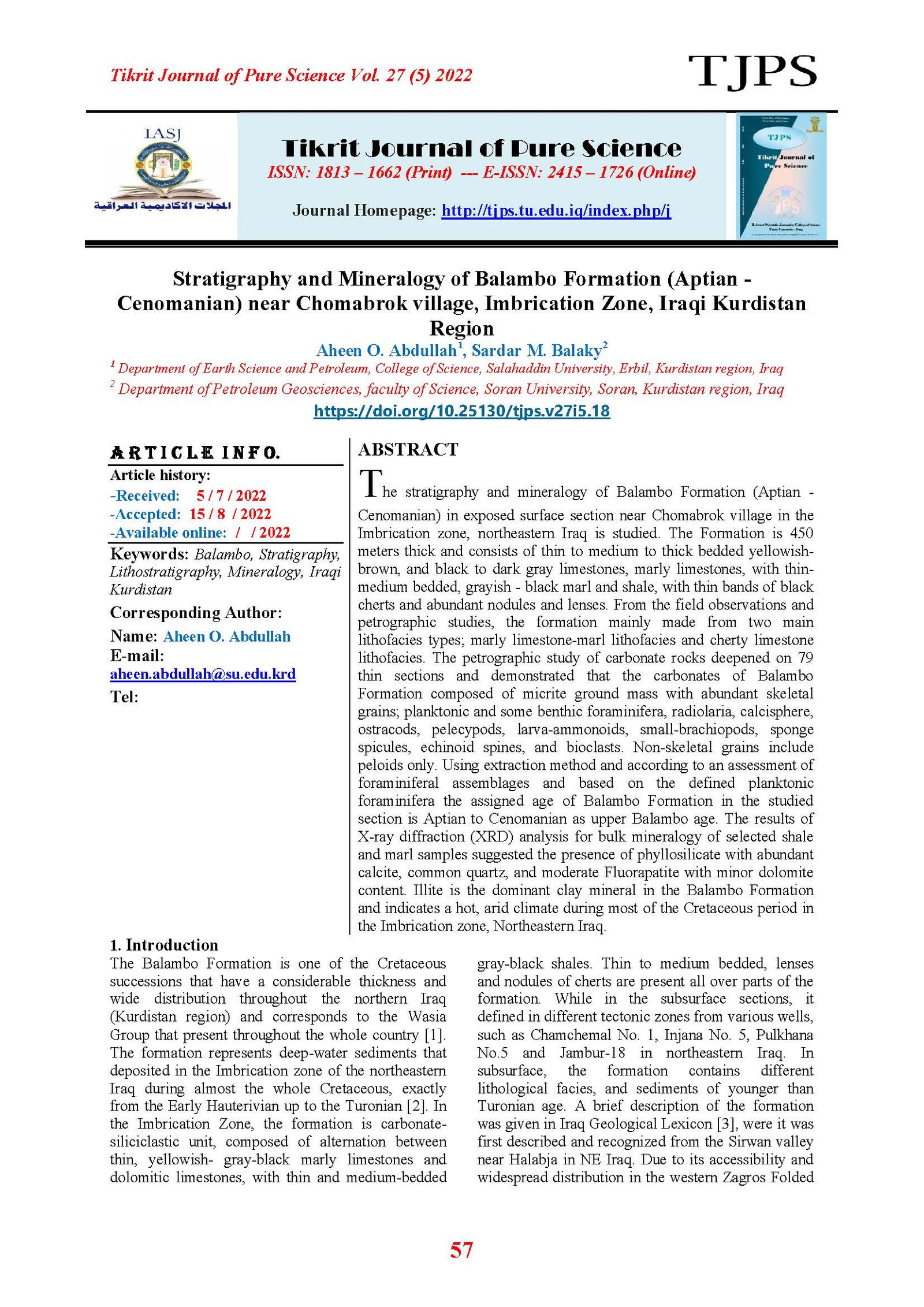Stratigraphy and Mineralogy of Balambo Formation (Aptian - Cenomanian) near Chomabrok village, Imbrication Zone, Iraqi Kurdistan Region
Main Article Content
Abstract
The stratigraphy and mineralogy of Balambo Formation (Aptian - Cenomanian) in exposed surface section near Chomabrok village in the Imbrication zone, northeastern Iraq is studied. The Formation is 450 meters thick and consists of thin to medium to thick bedded yellowish-brown, and black to dark gray limestones, marly limestones, with thin- medium bedded, grayish - black marl and shale, with thin bands of black cherts and abundant nodules and lenses. From the field observations and petrographic studies, the formation mainly made from two main lithofacies types; marly limestone-marl lithofacies and cherty limestone lithofacies. The petrographic study of carbonate rocks deepened on 79 thin sections and demonstrated that the carbonates of Balambo Formation composed of micrite ground mass with abundant skeletal grains; planktonic and some benthic foraminifera, radiolaria, calcisphere, ostracods, pelecypods, larva-ammonoids, small-brachiopods, sponge spicules, echinoid spines, and bioclasts. Non-skeletal grains include peloids only. Using extraction method and according to an assessment of foraminiferal assemblages and based on the defined planktonic foraminifera the assigned age of Balambo Formation in the studied section is Aptian to Cenomanian as upper Balambo age. The results of X-ray diffraction (XRD) analysis for bulk mineralogy of selected shale and marl samples suggested the presence of phyllosilicate with abundant calcite, common quartz, and moderate Fluorapatite with minor dolomite content. Illite is the dominant clay mineral in the Balambo Formation and indicates a hot, arid climate during most of the Cretaceous period in the Imbrication zone, Northeastern Iraq.
Article Details

This work is licensed under a Creative Commons Attribution 4.0 International License.
Tikrit Journal of Pure Science is licensed under the Creative Commons Attribution 4.0 International License, which allows users to copy, create extracts, abstracts, and new works from the article, alter and revise the article, and make commercial use of the article (including reuse and/or resale of the article by commercial entities), provided the user gives appropriate credit (with a link to the formal publication through the relevant DOI), provides a link to the license, indicates if changes were made, and the licensor is not represented as endorsing the use made of the work. The authors hold the copyright for their published work on the Tikrit J. Pure Sci. website, while Tikrit J. Pure Sci. is responsible for appreciate citation of their work, which is released under CC-BY-4.0, enabling the unrestricted use, distribution, and reproduction of an article in any medium, provided that the original work is properly cited.
References
[1] Jassim S. Z., and Goff, J. C. (2006). Geology of Iraq. Publishers Dolin and Moravian Museum: Prague: 341pp. [2] Buday, T. (1980). The regional geology of Iraq, Stratigraphy and paleogeography, Dar AL-Kuttib Publication House. University of Mosul: Iraq: v. 1, 445 p. [3] Bellen, R. C., Van Dunnington, H. V. Wetzel, R., and Morton, D. (1959). Lexique Stratigraphic International. Asie, Fasc. 10a, Iraq, Paris: 333pp. [4] A Hammoudi, R. and S Abawi, T.(2008). Biostratigraphy of the Balambo Formation (Lower Cretaceous) in Jebel Azmer–Sulaimaniya Area, Northeastern Iraq. Iraqi National Journal of Earth Sciences, 8(1), pp.24-33. [5] Ahmed, S.H; Barrier, É. and Müller, C. (2016). Basin evolution model during cretaceous in the northeastern of Arabian plate in Kurdistan region. Arabian Journal of Geosciences, 9(14), pp.1-23. [6] Al-Mutwali, M.M.; Al-Banna, N.Y. and Al-Abbasi, M.W. (2018). Biostratigraphy of Upper Valanginian-Upper Aptian Balambo Formation Near Barsarin Village in Rawanduz Area, Northeastern Iraq. pp.1-12.
[7] Al-Khafaf, E. and Al-Mutwali, M., 2019. Calcareous nannofossils biostratigraphy of the Lower Part of Balambo Formation (Lower Cretaceous) in Azmir Anticline-Northeastern Iraq. Iraqi National Journal of Earth Sciences, 19(1), pp.19-38. [8] Al-Miamary, F.A. (2021). Study of some oceanic anoxic events (OAE1) in the Early Cretaceous Balambo Formation using sedimentological and geochemical data at selected sections from northern Iraq.Ph.D. thesis, University, Mosul, Iraq: 206 pp. [9] Balaki, H.G. (2004). Geometry and structural history of Zozik-Rola and Spi Balies-Mama Ruta structures of the Zagros fold thrust belt in NE Iraqi Kurdistan. MSc.thesis, University, Salahadin, Iraq: 103pp. [10] Chamley, H. (1989). Clay Sedimentology. Spring-Verlag, Berlin: Heidelberg: 623 pp. [11] Burley, S.D.; Kantorowicz, J.D. and Waugh, B.(1985). Clastic diagenesis. Geological Society, London, Special Publications, 18(1), pp.189-226. [12] Morad, S. Worden, R. H. and Ketzer, J. M. (2003). Oxygen and hydrogen isotopic composition of diagentic clay minerals in sandstone: a review of the data and controls. International Association of Sedimentolgists. Special Publication. 34. p. 63-91. [13] Millot, G. and Thiry, M. (1987). Mineralogical forms of silica and their sequence of formation in silcretes. Journal of Sedimentary Research, 57 (2), pp.343-352. [14] Ghandour, I. et al (2004). Textural, mineralogical and microfacies charecteristics of the Lower Paleogene succession at the Nile valley and Kharga Oasis regions, Centeral Egypt, Jour. of Geoscience, Osaka City University, Vol. 47, Art. 4, pp. 39-53. [15] Sharland, P. R; Archer, R. Casey, D. M., Davies, R. B. Hall, S. H. Heward, A. P. Horbury, A. D., and Simmons, M. D.(2001). Arabian Plate Sequence Stratigraphy, Geo Arabia, Special publication 2, Gulf Petro Link, Bahrain, 372p. [16] Deconinck, J. F.et al (1989). Paleoenvironmental and diagenetic significance of Aptian to Eocene clay mineral successions of the Umbria-Marche basin (Northern Apennines, Italy). In: Abstract. International Conference (A.I.P.E.A)., Strasbourg. p. 23-28.
